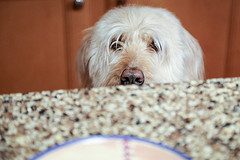
Photo by ransomtech on Flickr
Counter Surfing
Canine ancestors had to scavenge and hunt to survive, and that tendency lives on in today’s domestic dogs. They really can’t imagine a good reason to pass up a seemingly abandoned meatball or sandwich, and will continue to search our homes for food as long as we give them a reason! It’s just natural.
Aside from the aggravation of finding that Fido has scarfed down your gourmet dinner, if he chows down on something dangerous (inedible or poisonous), the result could be expensive or even tragic. To counteract counter-surfing, have a plan that includes Management, Redirection, and Training.
MANAGEMENT
Eliminate opportunities to scavenge, and keep your dog out of prime surfing areas, like the kitchen.
REDIRECTION
Provide a fun activity that appeals to your dog more than scavenging.
TRAINING
Give your dog a job that pays; the bigger the reward, the better.
Manage the Environment
- Make sure food is not left out. If you can’t put the food away, place it out of reach, such as on a high shelf or in the microwave or oven.
- Make sure no furniture or object nearby can allow your dog to jump on a counter. Yes, some dogs “rearrange” furniture for better foraging!
- Use a baby gate or put your dog behind closed doors when you are not able to supervise (e.g., when you have company).
Manage your Dog
- Keep an eye on your dog . . . supervise, supervise, supervise.
- Use a dragged leash or tether to keep your dog from unattended food.
Never use a drag leash or a tether unless you are in the room to prevent accidents. A drag leash or tether can be risky for your dog if it gets hung up on something. - If your dog is a total food hound, several small meals a day may help discourage counter surfing.
- If your dog is on a diet, ask your vet or independent pet store to recommend a high-fiber, low-calorie food that will keep your dog from feeling so hungry that he can’t resist looking for unattended food.
Redirect Your Dog’s Attention
- Give your dog stimulating interactive food puzzle toys to replace the urge to hunt for food. The more his physical and mental needs are met, the better.
- Play sniffing games. Hide your dog’s favorite toy or piece of food where he can’t get to it, while your dog is watching. Get him excited. Release him while saying “seek” or “find it.” Hide and seek for treats and toys engages your dog’s sense of smell and problem-solving skills, providing the calming effects of mental stimulation. For more information on these fun games, visit Suzanne Clothier’s website.
Train an Incompatible Behavior
- Catch your dog practicing polite kitchen behaviors. Reward him every single time all four paws are on the floor—sit, down, stand, and stays too. Catch him in the act of doing something good, and make kitchen manners pay off more than jumping on you or swiping food.
- Teach your dog to lie down on a specific spot, mat, or dog bed when he’s in the kitchen. If you prefer, teach him to lie down just outside the kitchen. Check out “5 Steps to Train Your Dog to Go to Place” on Karen Pryor’s website.
- Train Drop It or Leave It. For guidance on drop it and how to do a “trade” with your dog, check out this excellent guide. For leave it, Laurie Luck’s video is a must-see.
Key Points to Remember
- Don’t leave food on the counter.
- When you can’t supervise your dog, keep him out of the kitchen.
- Several smaller meals and a different food may make scavenging less tempting.
- Provide interactive food puzzle toys and play sniffing games to help satisfy your dog’s need to scavenge.
- Reward polite manners when you are in the kitchen with your dog.
- Train your dog to “leave it” and, just in case, to “drop it”.
Resources
Diamonds in the Ruff, “The Counter Thief”
The Karen Pryor Academy, “How to Put an End to Counter-Surfing”
Your Dog’s Friend is a 501-c3 non-profit organization that educates and supports dog parents. We offer behavior and training advice; sponsor FREE workshops on a variety of topics; run positive dog training, behavior-related, and sports classes; refer dog parents to trainers, dog walkers, and other professionals; and send an e-newsletter with articles, resources, and announcements.
This material is not intended to be a substitute for professional help when dealing with dogs with intense or potentially dangerous behavior issues. Consider consulting a positive reinforcement trainer or animal behaviorist for situations that you feel are dangerous or that you don’t feel equipped to handle. A list of recommended trainers and behaviorists can be found on our website, www.yourdogsfriend.org.




